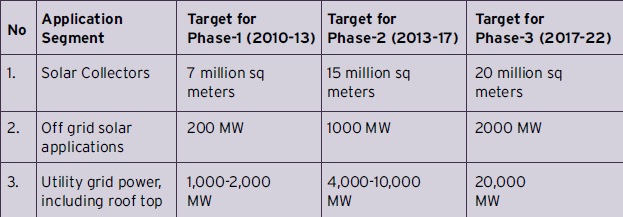 “The cost of solar power is coming down. Even without government subsidy solar power is available at `9 per unit,” says Tarun Kapoor, Joint Secretary (Solar), Ministry of New and Renewable Energy, Government of India, in conversation with Nayana Singh
“The cost of solar power is coming down. Even without government subsidy solar power is available at `9 per unit,” says Tarun Kapoor, Joint Secretary (Solar), Ministry of New and Renewable Energy, Government of India, in conversation with Nayana Singh
What is your vision for the National Solar Mission?
The National Solar Mission is thoroughly dedicated to ensuring that there is huge increase in generation of solar energy in the country. The nation has abundant sunshine and with right kind of technology and strategy we can use sun’s power to fuel a large percentage of the nation’s power related needs. Another important focus of the National Solar Mission is to develop India as a manufacturing hub of solar energy. We are working on Research and Development in order to come up with indigenous technology to provide solar energy to those who do not have electricity facilities. The success of solar energy sector within the country largely depends on favourable government policies, which should be designed to foster growth of the sector.

What steps would you suggest to overcome the challenges?
There is a lot of technological development taking place worldwide. We need to adopt some innovative technology and also work upon R&D on our own, so as to fit the technologies according to our needs. In India, the atmosphere is a little dustier, direct radiation of sunlight is a little less, temperatures are high and also, maintenance costs are relatively higher. Keeping these factors in mind, the technologies should be designed to adapt to Indian conditions. We must strive to bring down the price of solar power further. If we can increase the scale of projects, take to larger projects, the prices are doing to come down. From our end, we are trying to intervene directly from the government’s end and trying to buy big volumes of power.

What policies is the Mission coming up with to set up an enabling environment for solar power?
We already have with us a few ongoing policies. The Renewable Purchase Obligation for solar power begins at 2.5 percent, and goes up to 3 percent by 2022. We have set up a monitoring cell in the Ministry to ensure that this is enforced by the State Governments. The Govt. is doing its our best to ensure that the distributors take it seriously. We are in the process of finishing Phase I of the Solar Mission. We had set certain targets for this phase, which have been fulfilled well before time. The Phase II has a target of 3000MW of grid connected power. At persent, this target is being worked upon. The government is trying to come up with some direct or indirect subsidies and other mechanisms to bring down the cost of solar power and make it affordable for the distribution companies to purchase.
What are the major challenges to the development of solar power in the country?
High cost of solar power is major cause of concern. India is a price conscious market and it is not possible for us to burden consumers with high charges. The cost of solar power is coming down gradually. When we started the Solar Mission, the price of every unit of power was `18, which has now come down to Rs. Seven per unit. We hope that the price of solar power will come down further and grid parity will get attained quite soon. Lack of awareness is yet another challenge for us. Diesel generated power is available at `14 or 15 per unit, whereas, solar power, even without government subsidy is available at `9 per unit. The industry is not coming forward in a big way, because they have not yet understood the sector. Definitely, we have lot of convincing to do.
What steps are being taken to bring down the cost of solar power?
 We are pursuing the strategy of indigenisation; we are encouraging manufacturing at home. We also need to cut down some of the prevalent taxes. These are the key things that we are working on right now. The government is already taking initiatives to promote solar energy. Certain measures that the government is adopting, such as accessory depreciation being provided for solar power plants, tax cuts on import on import of raw materials and machinery for the solar energy sector. We can hope that as companies within India gets more and more competent, and the manpower gets trained, the efficiency level will soar up and the costs will get curbed.
We are pursuing the strategy of indigenisation; we are encouraging manufacturing at home. We also need to cut down some of the prevalent taxes. These are the key things that we are working on right now. The government is already taking initiatives to promote solar energy. Certain measures that the government is adopting, such as accessory depreciation being provided for solar power plants, tax cuts on import on import of raw materials and machinery for the solar energy sector. We can hope that as companies within India gets more and more competent, and the manpower gets trained, the efficiency level will soar up and the costs will get curbed.
The National Solar Mission envisages having a generation capacity of 20,000 MW by 2022. What kinds of technologies are being considered for fulfilling this ambition of having a generation capacity of up to 20,000 MW through solar means?
In harnessing solar energy, photovoltaic and solar-thermal are the key technologies involved. Within these two parent technologies, there are many sub categories. We do not profess the adoption of any particular technology It is for different organisations to choose which one fits them the best. Our projects encompass a wide range of technologies. In solar thermals, certain technologies are being left out. We are coming up with pilot projects to find out what fits best in India.
“High cost of solar power is major cause for concern, but it is coming down gradually”
Solar power can also lead to lot of off grid opportunities, especially in the rural areas. Do you think that India should seriously pursue the idea of offgrid power?
In the Indian context, off grid energy is very important, even more important than grid power. With very little off grid power, we can cover large number of families. Keeping this in mind, we have taken out major programmes for supporting off grid. We need to fulfil the immediate electricity needs using solar energy. We are giving direct 30 percent subsidy; for special cases the subsidy rates go up to 90 percent. We are working on a solar charging station project, which will have 100 solar charging stations with 50 solar lanterns and 10 mobile charging posts. This project will lead to creation of 6000 solar charging stations. We also support setting up of mini grids though our schemes. We provide subsidies of up to `150 per watt places like Chattisgarh and UP. We are also implementing programmes through NABARD by which tube lights and solar panels are given. Collaboration with NABARD can lead to 40 percent subsidy and the remaining amount can be secured as loan.
USA has imposed anti-dumping duties on Chinese Imports. The global trade was extended this month to Europe. Even Indian Solar Manufacturers’ have petitioned for safe-guard duties against Chinese, US, Malaysian and Taiwanese imports. What is the department position on it?
The commerce ministry is looking after it. As far as we are concerned, we always support domestic manufacturers. The domestic manufacturers should be able to get good value to their products and services, and there should also be a healthy competition in the market.
When is the National Solar Mission Phase 2 public consultation process likely to start?
The National Solar Mission Phase 2 is on its way. We are organising meetings and taking to our various stakeholders and we will be setting off with it shortly.
Be a part of Elets Collaborative Initiatives. Join Us for Upcoming Events and explore business opportunities. Like us on Facebook , connect with us on LinkedIn and follow us on Twitter, Instagram.











